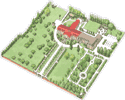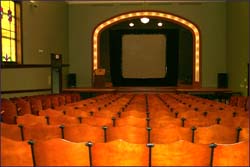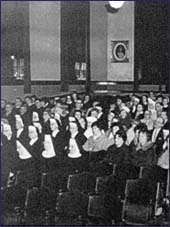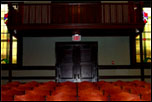
| PLACES |
| Chapel |
| Humboldt Gates |
| Academy Green |
| Arboretum |
| Former Cemetery |
| 1871 Building |
| Convent |
| Interpretive Centre |
| 1910 Addition |
| Auditorium |
| Orchard |
| Novitiate Garden |
| Courtyard |
 |
Auditorium
Large windows with coloured art-glass panes were installed at the time of construction. The work is that of A.J. Roy, a local glazier with a shop on Yates Street. These windows were beautiful to look at, but allowed far too much light during afternoons when the Sisters attempted to show films for the pupils. Mr. Roy left his signature on the window over the main entrance, and when the craftspeople of Mercer and Schaefer Glass Studios completed the restoration of the glass work in the auditorium, they too followed the tradition of signing one of the windows.
The "flag
gallery" above the stage was an area hidden from the audience,
where costumes were stored and backstage work was done during performances.
A projectionist's booth was built off the rear wall, over the entrance.
This wooden platform could hold equipment such as film projectors.
Although enclosed by a wooden railing, this booth was open to the
audience and stage. There was very little in the way of a "backstage"
area, but 10 music practice rooms were built behind the stage, on
two levels. Click
for more on the Auditorium
Contact
St. Anns Academy at stanns.academy@gems2.gov.bc.ca
Contact the Webmaster at zeroone@zeroonedesign.com
|



